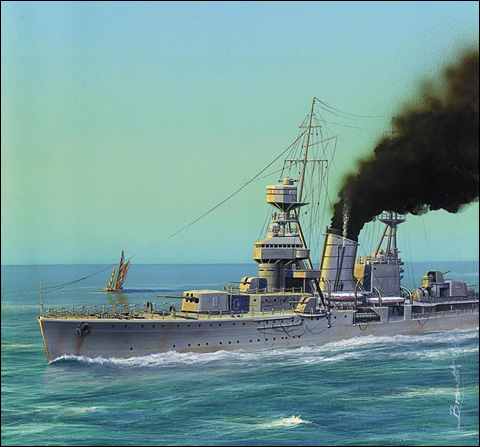KAIBOKAN!
 (Chinese Ning Hai-class light cruiser)
(Chinese Ning Hai-class light cruiser)
IJN ISOJIMA: Tabular Record of Movement
© 2008 Bob Hackett and Sander Kingsepp
1 January 1930:
Aioi, Japan. Laid down at the Harima shipyard for the Chinese Navy as a light cruiser of Japanese design.
10 October 1931:
Launched and named NING HAI.
31 July 1932:
Completed. Equipped with two Aichi AB-3 single seat twin-float seaplanes.
24 August 1932:
Departs Kure.
26 August 1932:
Arrives at Shanghai.
1 September 1932:
Designated flagship of the Chinese 1st Fleet. Captain Shen is the Commanding Officer.
May 1933:
Aioi. Undergoes repairs and refit at the Harima shipyard.
3 June 1934:
Arrives at Moji.
5 June 1934:
Arrives at Yokohama, with the training squadron commander Rear Admiral Wang embarked, to participate
in the state funeral for Admiral of Fleet Togo Heihachiro, Japan's national hero of the 1905 Russo-Japanese War.
14 June 1934:
Departs Yokohama.
June 1934:
Arrives at Aioi. Undergoes repairs and refit at Harima.
14 July 1934:
Repairs are completed,
7 July 1937: The Marco Polo Bridge (The First "China") Incident:
Hun
River, Lugouqiao, China. Japanese troops on night maneuvers at the bridge
fire blank cartridges. Nearby Chinese troops fire back, but do not cause injuries.
Later, the Japanese discover a soldier missing and assume the Chinese captured
him. They demand entry to a suburb of Peking (Beijing) to look for him, but the Chinese refuse. The
Japanese shell the city and an undeclared war on China begins.
11 July 1937:
The IJA and IJN agree to operational jurisdictions in China. The IJA
takes responsibility for northern China and the IJN assumes assumes responsibility for central and
southern China. The IJN's air power in-theater at this time consists of only about 80 planes carried
by carriers KAGA, RYUJO and HOSHO on station in the East China Sea.
August 1937:
The Chinese Nationalist Government sends NING HAI and sister PING HAI, old cruiser YING JUI and a gunboat down the Yangtse River to Koin (Chiang Yin) to help defend Nanking, the Nationalist's capital city.
22-23 September 1937:
Koin. NING HAI is attacked several times by aircraft from carrier KAGA and the ground-based 2nd Combined Air Flotilla. She sustains hits by four bombs and several near misses.
25 September 1937:
Six Yokusuka B3YI attack bombers of the 2nd Combined Air Flotilla score two direct hits on NING HAI. She sinks
in shallow water upstream of Koin.
5 December 1937:
The IJN captures the wreck of NING HAI.
April 1938:
The Japanese attempt to salvage NING HAI, but fail and two divers are killed.
5 May 1938:
NING HAI is refloated successfully.
May 1938:
Towed to Shanghai. Undergoes basic repairs at Kiangnan shipyard. Later, the hulk is towed to Sasebo.
11 July 1938:
NING HAI is re-classified as a coastal defense ship and training vessel. Renamed MIKURA.
1938-1943:
Sasebo. MIKURA serves as an accomodation hulk.
December 1943:
Aioi. MIKURA undergoes reconstruction at Harima.
1 June 1944:
Renamed ISOJIMA. [1]
10 June 1944:
Registered in the Kure Naval District as a kaibokan coast defense ship.
20 June 1944:
Assigned to the Yokosuka Guard Unit.
23 June 1944:
Reserve LtCdr Hukuchi Akiji assumes command.
28 June 1944:
Completes reconstruction. Begins training in the Inland Sea.
9 July 1944:
Arrives at the Yokosuka Guard Unit.
22 July 1944:
Departs Yokosuka escorting a convoy of unidentified ships to Iwo Jima.
26 July 1944:
ISOJIMA avoids a torpedo fired by an unknown submarine. [2]
27 July 1944:
Arrives at Iwo Jima.
29 July 1944:
Departs Iwo Jima.
1 August 1944:
Arrives at Yokosuka.
19 September 1944:
ISOJIMA departs Yokosuka escorting a convoy of unidentified ships accompanied by several escorts.
85 nms from Hachiji Jima. At about 0553, LtCdr Lawrence V. Julihnís USS SHAD (SS-235) fires four Mark-23 steam torpedoes and gets three hits on ISOJIMA. She sinks at 33-40N, 138-20E. LtCdr Hukuchi is KIA.
Other losses are unknown.
SHAD endures a lengthy depth charging by the other escorts.
10 November 1944:
Removed from the Navy List.
Authors' Notes:
[1] ISOJIMA is also known as ISOSHIMA.
[2] This may have been LtCdr Edward Blakely's USS SHARK (SS-314). According to data compiled by COMSUBPAC's Submarine Operations Research Group (SORG), that same day, Blakely attacked a ship
identified as a "1500-ton destroyer" north of the Bonin Islands. In Oct '44, SHARK was lost with all hands,
probably in the Luzon Strait.
- Bob Hackett and Sander Kingsepp.
Back to
Escort Page





